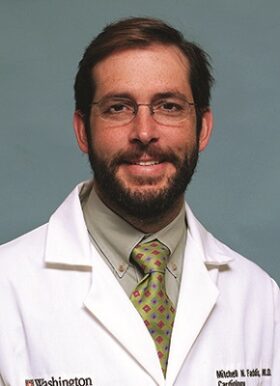
Mitchell N. Faddis, MD, PhD
Professor of Medicine
Director, Electrophysiology
- Phone: 314-362-1291
- Fax: 314-454-8250
Related Links
Education
- Bachelor of Science, Biology (Cum Laude): Kansas State University, Manhattan, KS (1985)
- Medical Scientist Training Program MD, PhD in Neurosciences: Washington University School of Medicine, St. Louis, MO (1993)
- Internal Medicine Resident: Washington University, St. Louis, MO (1995)
- Fellowship, Cardiology: Washington University, St. Louis, MO (1997)
- Fellowship, Electrophysiology: Barnes-Jewish Hospital, Washington University, St. Louis, MO (1998)
Board Certifications
- Cardiovascular Disease
- Electrophysiology
Clinical Interests
Diagnosis and treatment of cardiac rhythm disturbances and advanced heart failure. Specializing in treatments that include catheter ablation of atrial fibrillation and other complex arrhythmias, treatment of advanced heart failure with cardiac resynchronization therapy, and implantation of permanent pacemakers and defibrillators.
Research Interests
I participate in the development of biomedical technology for clinical cardiac electrophysyiology. I am currently pursuing two avenues of investigation. The first is the development of a catheter that will perform curative ablation of atrial fibrillation. Atrial fibrillation is the most common rhythm disorder affecting more than two million people in the United States alone. At present, there is no uniformly effective treatment strategy for this cardiac rhythm disturbance. Two prominent shortcomings of currently available catheter systems are a lack of precision in intracardiac navigation and a lack of spatial resolution of fluoroscopic imaging of navigation targets within the heart. We have helped develop a magnetically guided catheter that is deflected by an external magnetic field. We are investigating the use of this system for ablation of atrial fibrillation.
A second avenue of research is the use of an electronic cardiac pacemaker as a primary treatment for congestive heart failure. In approximately one third of all patients with congestive heart failure, there is a concomitant defect in the conduction system of the heart that results in a prominent discoordination of ventricular contraction. The result is a mechanical inefficiency that compromises ejection of blood from the heart. This discoordination is corrected by the placement of pacemaker leads on opposite walls of the left ventricle (free wall and septum). The LV free wall is reached by navigating branches of the coronary sinus. We are developing a magnetic guidewire that will reach terminal branches of the coronary sinus. We are developing a modeling strategy to optimize cardiac resynchronization through optimal targeting of a coronary sinus branch for pacemaker lead deployment, and we are investigating new strategies for optimizing outcomes achieved with this pacemaker system.